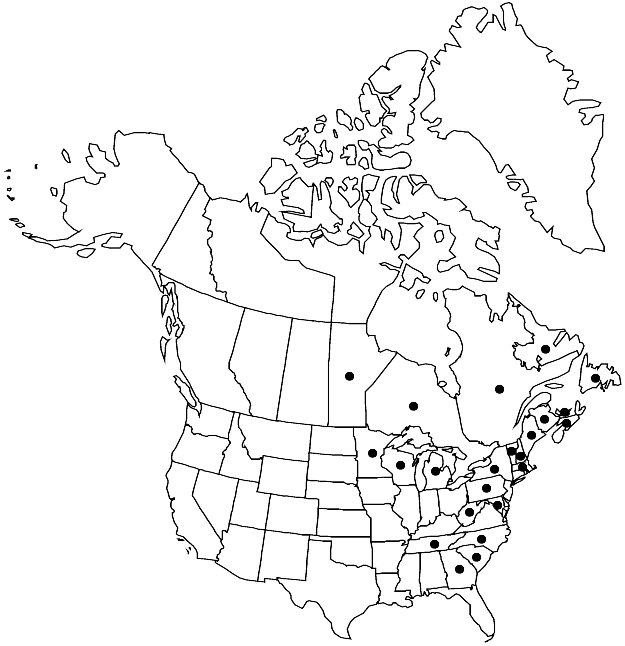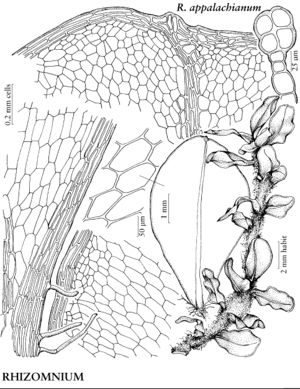Difference between revisions of "Rhizomnium appalachianum"
Ann. Bot. Fenn. 10: 11, figs. 38–48. 1973.
imported>Volume Importer |
imported>Volume Importer |
||
| Line 57: | Line 57: | ||
|publication year=1973 | |publication year=1973 | ||
|special status=Endemic;Illustrated | |special status=Endemic;Illustrated | ||
| − | |source xml=https:// | + | |source xml=https://bitbucket.org/aafc-mbb/fna-data-curation/src/2e0870ddd59836b60bcf96646a41e87ea5a5943a/coarse_grained_fna_xml/V28/V28_381.xml |
|genus=Rhizomnium | |genus=Rhizomnium | ||
|species=Rhizomnium appalachianum | |species=Rhizomnium appalachianum | ||
Latest revision as of 21:35, 5 November 2020
Plants 4–8(–12) cm. Stems dark reddish brown or brown when old; micronemata present. Leaves green or dark green, slightly or moderately contorted, broadly elliptic, obovate, or rarely orbicular, 6.5–10(–13) mm; margins reddish, brown, rarely green, or blackish with age, 2-stratose; apex rounded or sometimes retuse, bluntly apiculate; costa percurrent, rarely subpercurrent or ending well before apex; medial laminal cells elongate or short-elongate, (50–)100–180(–210) µm, not or weakly collenchymatous, walls rarely weakly pitted; marginal cells linear, in 2–3(–4) rows. Sexual condition dioicous. Seta 1.5–3.5 cm. Capsule oblong or cylindric, 2–3 mm; operculum conic-rostrate; exostome yellow-brown, lamellae 18+. Spores 29–41 µm.
Phenology: Capsules mature summer.
Habitat: Swamps, seeps, along lakeshores and stream banks on logs, moist soil, humus, rock
Elevation: low to moderate elevations
Distribution

Man., N.B., Nfld. and Labr., N.S., Ont., P.E.I., Que., Ga., Maine, Md., Mass., Mich., Minn., N.H., N.Y., N.C., Pa., S.C., Tenn., Vt., W.Va., Wis.
Discussion
Rhizomnium appalachianum and R. magnifolium are not only macroscopically similar, but also consistently overlap in a number of microscopic traits, including length of the costa, marginal coloration, and apex morphology. This prompted H. A. Crum and L. E. Anderson (1981) to consider them varieties of Mnium punctatum (as vars. appalachianum and elatum). A few characters in addition to those in the key may help separate the species. Laminal cells adjacent to the leaf margins of R. appalachianum are often much smaller than the cells adjacent to the costa and more or less isodiametric. Laminal cells near the margins of R. magnifolium contrast less in size with the medial cells and are often short-elongate and less commonly more or less isodiametric. Rhizoids are sometimes present along leaf bases of R. appalachianum and are usually, but not always, absent in R. magnifolium. Rhizomnium appalachianum is a generally larger plant than R. magnifolium, has broader leaves which are nearly orbicular in some instances, and have a tendency to be slightly ruffled or bent when moist and do not lie flat on a slide; the leaves of R. magnifolium usually readily flatten.
Selected References
None.
